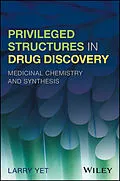A comprehensive guide to privileged structures and their application in the discovery of new drugs
The use of privileged structures is a viable strategy in the discovery of new medicines at the lead optimization stages of the drug discovery process. Privileged Structures in Drug Discovery offers a comprehensive text that reviews privileged structures from the point of view of medicinal chemistry and contains the synthetic routes to these structures. In this text, the author-a noted expert in the field-includes an historical perspective on the topic, presents a practical compendium to privileged structures, and offers an informed perspective on the future direction for the field.
The book describes the up-to-date and state-of-the-art methods of organic synthesis that describe the use of privileged structures that are of most interest. Chapters included information on benzodiazepines, 1,4-dihydropyridines, biaryls, 4-(hetero)arylpiperidines, spiropiperidines, 2-aminopyrimidines, 2-aminothiazoles, 2-(hetero)arylindoles, tetrahydroisoquinolines, 2,2-dimethylbenzopyrans, hydroxamates, and bicyclic pyridines containing ring-junction nitrogen as privileged scaffolds in medicinal chemistry. Numerous, illustrative case studies document the current use of the privileged structures in the discovery of drugs. This important volume:
- Describes the drug compounds that have successfully made it to the marketplace and the chemistry associated with them
- Offers the experience from an author who has worked in many therapeutic areas of medicinal chemistry
- Details many of the recent developments in organic chemistry that prepare target molecules
- Includes a wealth of medicinal chemistry case studies that clearly illustrate the use of privileged structures
Designed for use by industrial medicinal chemists and process chemists, academic organic and medicinal chemists, as well as chemistry students and faculty, Privileged Structures in Drug Discovery offers a current guide to organic synthesis methods to access the privileged structures of interest, and contains medicinal chemistry case studies that document their application.
Autorentext
Larry Yet, PhD, is an Assistant Professor in the Department of Chemistry at the University of South Alabama. He has authored or coauthored more than 40 publications, is an inventor on several non-provisional and issued patents, and has written multiple invited book chapters and review articles in synthetic organic and medicinal chemistry.
Inhalt
1 Introduction 1
1.1 The Original Definition of Privileged Structures 1
1.2 The Role of Privileged Structures in the Drug Discovery Process 1
1.3 The Loose Definitions of Privileged Structures 2
1.4 Synthesis and Biological Activities of Carbocyclic and Heterocyclic Privileged Structures 2
1.4.1 Synthesis and Biological Activities of Three?] and Four?]Membered Ring Privileged Structures 2
1.4.2 Synthesis and Biological Activities of Five-Membered Ring Privileged Structures 2
1.4.3 Synthesis and Biological Activities of Six-Membered Ring Privileged Structures 4
1.4.4 Synthesis and Biological Activities of Bicyclic 5/5 and 6/5 Ring Privileged Structures 4
1.4.5 Synthesis and Biological Activities of Bicyclic 6/6 and 6/7 Ring Privileged Structures 4
1.4.6 Synthesis and Biological Activities of Tricyclic and Tetracyclic Ring Privileged Structures 4
1.5 Combinatorial Libraries of Privileged Structures 4
1.6 Scope of this Monograph 9
References 10
2 Benzodiazepines 15
2.1 Introduction 15
2.2 Marketed BDZ Drugs 15
2.2.1 1,4-Benzodiazepine Marketed Drugs 15
2.2.2 1,5-Benzodiazepine Marketed Drugs 16
2.2.3 Linearly Fused BDZ Marketed Drugs 16
2.2.4 Angularly Fused-1,4-Benzodiazepine Marketed Drugs 17
2.3 Medicinal Chemistry Case Studies 17
2.3.1 Cardiovascular Applications 17
2.3.2 Central Nervous System Applications 19
2.3.3 Gastrointestinal Applications 23
2.3.4 Infectious Diseases Applications 24
2.3.5 Inflammation Applications 25
2.3.6 Metabolic Diseases Applications 27
2.3.7 Oncology Applications 28
2.4 Synthesis of BDZs 30
2.4.1 Condensation of o-Phenylenediamines to 1,5-Benzodiazepines 31
2.4.1.1 Condensation of o-Phenylenediamines with Ketones 31
2.4.1.2 Condensation of o-Phenylenediamines with ,-Unsaturated Ketones 33
2.4.1.3 Condensation of o-Phenylenediamines with Alkynes 34
2.4.2 Reductive Condensation of -Substituted Nitrobenzenes with Ketones and ,-Unsaturated Ketones 35
2.4.3 Intramolecular Cyclizations to 1,4-Benzodiazepines 35
2.4.3.1 Intramolecular CyclizationsPath A 36
2.4.3.2 Intramolecular CyclizationsPath B 37
2.4.3.3 Intramolecular CyclizationsPath C 39
2.4.3.4 Intramolecular CyclizationsPath D 40
2.4.3.5 Intramolecular CyclizationsPath E 42
2.4.3.6 Intramolecular CyclizationsPath F 42
2.4.3.7 Intramolecular CyclizationsPath G 42
2.4.3.8 Intramolecular CyclizationsPath H 42
2.4.4 Ugi Multicomponent Synthesis 42
2.4.5 Elaboration of 1,4-Benzodiazepines 44
2.4.6 Pyrrolo[2,1-c]benzodiazepines 45
2.4.7 Fused BDZ Ring Systems 45
2.4.8 Solid-Phase Synthesis of BDZs 47
References 47
3 1,4-Dihydropyridines 59
3.1 Introduction 59
3.2 Marketed 1,4-Dihyropyridine Drugs 59
3.3 Medicinal Chemistry Case Studies 59
3.3.1 Cardiovascular Applications 59
3.3.2 Central Nervous System Applications 61
3.3.3 Infectious Diseases Applications 62
3.3.4 Inflammation Applications 63
3.3.5 Men's and Women's Health Issues Applications 64
3.3.6 Metabolic Diseases Applications 65
3.3.7 Oncology Applications 65
3.4 Synthesis of 1,4-Dihydropyridines 66
3.4.1 Classical Hantzsch Synthesis 66
3.4.2 Modified Hantzsch Conditions 66
3.4.3 1,4-Disubstituted-1,4-Dihydropyridines 69
3.4.4 Organometallic Additions to Pyridinium Salts 69
3.4.5 From Imines and Enamino Compounds 71
3.4.6 Multicomponent Synthesis 72
3.4.6.1 Three-Component Synthesis of 1,4-Dihydropyridines 72
3.4.6.2 Four-Component Synthesis of 1,4-Dihydropyridines 74
3.4.7 Organocatalytic Synthesis of 1,4-Dihydropyridines 74
3.4.8 Miscellaneous Preparations 75
3.4.9 Elaboration of 1,4-Dihydropyridines 76
References 77
...